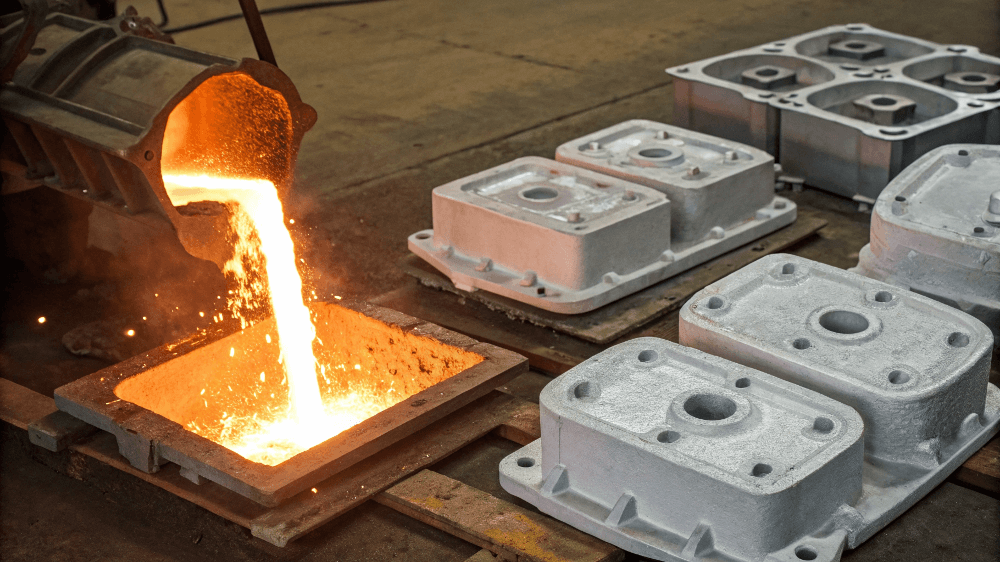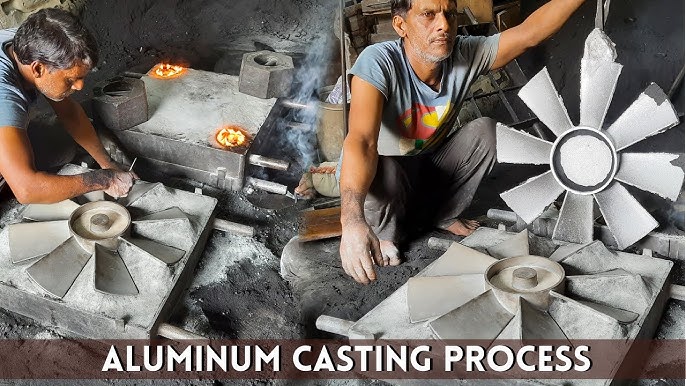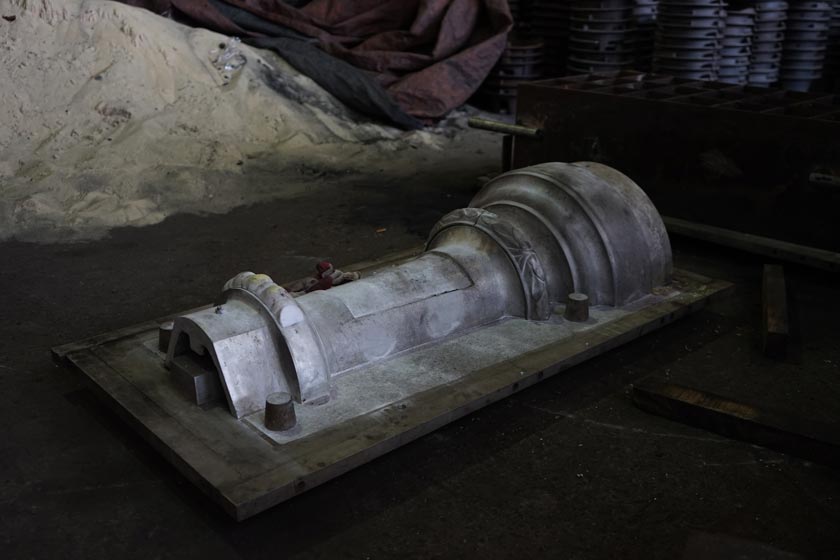Just How Aluminum Foundry Adds To Developments in Aerospace Engineering
Aluminum factories are integral to developments in aerospace design. They produce lightweight, high-strength elements that are crucial for modern-day airplane. Through innovative casting strategies, these foundries create complicated geometries that boost architectural honesty. In addition, the advancement of premium Aluminum alloys sustains the industry's concentrate on fuel performance and sustainability. Nonetheless, challenges continue to be in the production process. Recognizing these aspects reveals the profound influence of Aluminum on aeronautics's future.
The Importance of Lightweight Products in Aerospace Layout
As the aerospace sector remains to evolve, the relevance of lightweight materials ends up being significantly apparent. The demand for efficiency and sustainability drives engineers to prioritize using products that reduce total weight without endangering structural honesty. Light-weight materials, particularly Aluminum, play a vital function in boosting fuel efficiency, boosting payload capability, and raising the general efficiency of aircraft.
In addition, the assimilation of these materials permits for ingenious layouts, allowing suppliers to produce more aerodynamic shapes that can endure extreme conditions. The reduction in weight not just reduces operational expenses however additionally adds to a decreased environmental footprint, aligning with global efforts toward sustainability in air travel.
Advanced Spreading Techniques in Aluminum Foundries
Advanced spreading strategies in Aluminum foundries play an essential duty in aerospace design by allowing the production of accurate and lightweight parts. Developments in mold style and precision casting procedures are crucial in attaining optimal performance and structural integrity. Additionally, the growth of lightweight alloys enhances the overall performance and effectiveness of aerospace applications.
Innovative Mold And Mildew Style
Ingenious mold layout plays an essential duty in the effectiveness and effectiveness of Aluminum foundries, specifically within the aerospace field. By leveraging innovative materials and techniques, modern molds can be crafted to hold up against heats and stress, ensuring peak efficiency throughout the casting process. These styles typically include complex geometries that allow for the manufacturing of light-weight yet structurally audio components, essential for aerospace applications. In addition, using computer-aided style (CAD) software facilitates exact modeling, allowing shops to refine and replicate mold layouts before physical manufacturing starts. This not just enhances the high quality of actors parts however additionally decreases waste and preparation, leading to considerable price savings. Generally, innovative mold layout is a foundation of progression in Aluminum Foundry modern technology for aerospace design.
Precision Casting Processes
The efficiency of cutting-edge mold layouts perfectly incorporates with precision casting processes, which are crucial for producing high-grade Aluminum components in aerospace engineering. These processes, including sand spreading, pass away casting, and financial investment spreading, guarantee the creation of complicated geometries with tight tolerances. Advanced techniques like vacuum casting and pressure die casting enhance the stability and surface finish of the final products. Precision casting lessens product waste while optimizing the mechanical homes of Aluminum, vital for aerospace applications. Additionally, using real-time surveillance and advanced simulation tools during the spreading procedure enables instant modifications, causing enhanced high quality control. Collectively, these precision casting processes position Aluminum shops at the center of aerospace technology, sustaining the market's demand for dependability and performance.
Light-weight Alloy Growth
As aerospace engineers seek to boost gas performance and efficiency, lightweight alloy development comes to be an important focus in Aluminum shops. These factories employ advanced spreading methods to create alloys that provide premium strength-to-weight proportions. Advancements in alloy make-up, including the consolidation of aspects like lithium and magnesium, make it possible for the production of products that stand up to extreme conditions while reducing overall airplane weight. Techniques such as die spreading and investment spreading help with the accuracy manufacturing of intricate shapes, which are critical for aerospace applications. In addition, ongoing research intends to optimize these alloys for boosted mechanical residential or commercial properties and increased resilience. By focusing on light-weight alloy advancement, Aluminum foundries greatly add to the development of aerospace engineering, leading the way for extra lasting and reliable aircraft layouts.

Enhancing Structural Stability Via Aluminum Components
Aluminum components offer considerable benefits in enhancing structural honesty within aerospace engineering. Their lightweight nature contributes to total efficiency while maintaining strength, which is crucial for airplane efficiency. In addition, the stress and anxiety resistance properties of Aluminum aid assure the resilience and reliability of aerospace structures under various operational problems.
Light-weight Product Perks
While conventional materials frequently jeopardize weight for strength, utilizing Aluminum parts in aerospace engineering offers significant advantages in architectural honesty. Aluminum's lightweight nature contributes to total layout efficiency, permitting even more structured airplane that eat much less gas, therefore enhancing sustainability. The product's superb strength-to-weight ratio assurances that components keep toughness without adding unnecessary mass. This top quality promotes improved efficiency and dexterity in trip, in addition to optimized haul capacities. In addition, Aluminum's resistance to rust prolongs the life-span of aerospace structures, lowering maintenance prices and improving safety. As makers progressively embrace Aluminum alloys, the aerospace sector experiences a transformative shift in the direction of more reliable and efficient design services that focus on both performance and environmental responsibility.
Tension Resistance Qualities
Various materials have one-of-a-kind residential or commercial properties, Aluminum's outstanding stress resistance stands out as an important aspect in boosting the architectural honesty of aerospace components. This resistance plays a vital function in making certain that airplane can withstand various functional stress and anxieties, consisting of fatigue, impact, and environmental problems. Aluminum alloys, specifically engineered for aerospace applications, show high tensile stamina while maintaining lightweight attributes, enabling engineers to design much more efficient structures - Aluminum Foundry. Additionally, the capacity of Aluminum to endure cyclic loading without significant contortion contributes to the longevity and reliability of aerospace parts. As advancements continue in Aluminum Foundry techniques, the development of stress-resistant Aluminum parts assures further enhancements in performance, safety, and performance throughout the aerospace market, solidifying Aluminum's role as a recommended product in modern-day design
Fuel Performance Improvements Driven by Aluminum Innovations
As the aerospace sector looks for to improve fuel performance, ingenious uses of Aluminum have arised as an essential remedy. Aluminum's lightweight nature notably lowers airplane weight, enabling reduced fuel consumption throughout flight. go to this web-site This reduction in weight is essential, as even little decreases can lead to considerable enhancements in overall gas economic situation.
Advanced Aluminum alloys, created for enhanced toughness and durability, make it possible for manufacturers to develop components that preserve structural integrity while lessening mass - Aluminum Foundry. In addition, the integration of Aluminum in airframes and engine components helps with improved the rules of aerodynamics, adding to reduced drag and increased effectiveness
The adoption of Aluminum in aerospace not just fulfills the demand for fuel-efficient design but additionally straightens with governing pressures for reduced exhausts. As these innovations remain to develop, they play a significant function in establishing new benchmarks for gas effectiveness, guaranteeing that the aerospace sector can satisfy expanding economic and environmental challenges.

The Role of Aluminum in Sustainable Air Travel Practices
The enhancing focus on lasting aeronautics practices has placed Aluminum as an important material in the mission for greener airplane design. Recognized for its lightweight buildings, Aluminum substantially reduces airplane weight, bring about reduced fuel intake and emissions. Its recyclability additionally improves its sustainability profile, as Aluminum can be recycled forever without loss of quality. This characteristic sustains a round economic situation within the aeronautics sector, lessening waste and resource depletion.
In addition, advancements in Aluminum alloys have improved their toughness and deterioration resistance, enabling for longer life span and decreased maintenance needs. These innovations help with the growth of more effective airplane structures, adding to general sustainability efforts. In addition, Aluminum's thermal conductivity plays a vital duty in energy-efficient styles, enhancing systems such as warmth exchangers. Jointly, these characteristics underscore Aluminum's essential role ahead of time lasting air travel, lining up with international initiatives focused on minimizing the environmental impact of air travel.
Obstacles Encountered by Aluminum Foundries in Aerospace Production
While Aluminum foundries play an essential duty in aerospace manufacturing, they encounter substantial difficulties that can impact manufacturing performance and high quality. One major difficulty is the stringent quality assurance requirements required in the aerospace market. Any kind of flaw can compromise safety and security and performance, demanding rigorous inspection procedures that prolong production timelines. In addition, shops often contend with changing resources costs, which can impact prices and success. The complexity of Aluminum alloys made use of in aerospace applications further complicates the production process, as specific formulas are critical for achieving preferred mechanical properties. Skilled labor scarcities hinder the capability to keep top quality production levels. Lastly, environmental regulations impose constraints on emissions and waste monitoring, calling for foundries to purchase sustainable methods, which can be cost-prohibitive. These variables jointly develop a landscape where Aluminum factories should continuously adjust to satisfy the developing demands of aerospace manufacturing while guaranteeing safety and conformity.
Future Fads in Aluminum Applications for Aerospace Engineering
With improvements in modern technology and raising needs for efficiency, the future of Aluminum applications in aerospace design is poised for significant makeover. The assimilation of innovative Aluminum alloys and compounds is expected to boost strength-to-weight proportions, bring about even more fuel-efficient aircraft styles. Additionally, innovations in additive production strategies will allow for the manufacturing of complex Aluminum frameworks that were formerly impossible, optimizing efficiency and decreasing waste.

Lasting techniques will certainly play a vital role, with an expanding focus on reusing Aluminum to minimize environmental effect. The aerospace field is most likely to embrace smarter manufacturing processes, such as automation and expert system, making certain better and precision in Aluminum elements. In addition, collaborations between Aluminum foundries and aerospace business will promote r & d, leading the way for brand-new applications that fulfill the stringent requirements of modern aerospace engineering - Aluminum Foundry. On the whole, the future looks assuring for Aluminum's duty fit the skies
Regularly Asked Concerns
What Are the Ecological Effects of Aluminum Production in Aerospace?
The ecological influences of Aluminum production in aerospace include significant energy intake, greenhouse gas exhausts, and environment interruption. Furthermore, mining processes can result in dirt destruction and water contamination, elevating problems concerning sustainability and eco-friendly equilibrium.
Exactly How Does Aluminum Compare to Other Materials in Aerospace Applications?
Aluminum supplies a distinct combination of lightweight homes, rust resistance, and cost-effectiveness contrasted to other materials. Its high strength-to-weight ratio makes it particularly beneficial for aerospace applications, enhancing fuel efficiency and general efficiency in aircraft layout.
What Certifications Do Aluminum Foundry Workers Requirement for Aerospace Projects?
Aluminum Foundry workers need specialized training in metallurgy and spreading strategies, together with expertise of aerospace market standards. Qualifications in quality control and safety and security methods are likewise important to guarantee compliance with stringent aerospace job requirements.
Exist Any Safety And Security Issues With Making Use Of Aluminum in Aerospace Engineering?
Security problems relating to Aluminum in aerospace design include sensitivity to tiredness, stress and anxiety, and corrosion cracks. Proper treatment and alloy option are crucial to reduce these dangers, making certain architectural integrity and overall security in aerospace applications.
Exactly How Does Aluminum Recycling Benefit the Aerospace Market?
Aluminum recycling substantially benefits the aerospace industry by reducing material costs, reducing environmental effect, and preserving energy. This sustainable practice enhances the More Help sector's performance while promoting making use of light-weight, high-performance components in aircraft manufacturing.
Advanced spreading strategies in Aluminum factories play a crucial role in aerospace engineering by allowing the production of specific and light-weight components. Ingenious mold and mildew layout plays an essential role in the effectiveness and efficiency of Aluminum factories, specifically within the aerospace industry. As aerospace engineers seek to boost gas effectiveness i loved this and performance, light-weight alloy growth ends up being a necessary focus in Aluminum shops. Aluminum alloys, particularly engineered for aerospace applications, show high tensile toughness while preserving light-weight attributes, allowing designers to develop much more efficient frameworks. Partnerships between Aluminum shops and aerospace business will cultivate research study and development, leading the method for brand-new applications that fulfill the strict requirements of modern-day aerospace engineering.